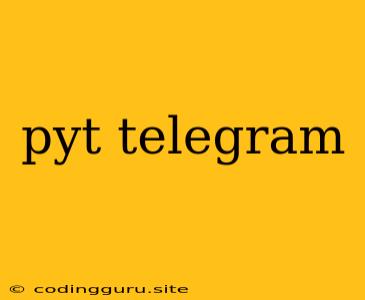Unlocking the Power of Telegram with Python: A Comprehensive Guide
The world of instant messaging is constantly evolving, and Telegram has emerged as a leading platform, boasting impressive features, robust security, and a vast user base. But what if you could leverage the power of Telegram for your own projects and applications? That's where Python comes in.
Why Python for Telegram?
Python's versatility and ease of use make it an ideal choice for interacting with Telegram's API. With its rich libraries and extensive community support, you can quickly build bots, automate tasks, and integrate Telegram seamlessly into your projects.
Getting Started with the Telegram Bot API
The first step in your Telegram journey is to create a bot. This is easily accomplished through the Telegram BotFather. Here's a quick guide:
- Find the BotFather: Search for "BotFather" in your Telegram app.
- Start a Conversation: Begin a conversation with BotFather.
- Create a New Bot: Type
/newbotand follow the instructions to create your bot and obtain its unique API token.
Python Libraries: Your Gateway to Telegram
Several powerful Python libraries simplify the process of interacting with Telegram. Two popular options are:
- python-telegram-bot: This comprehensive library offers a streamlined interface for building Telegram bots. Its documentation and community support make it a popular choice for beginners and experienced developers alike.
- telethon: Telethon provides a robust and versatile framework for working with Telegram, including sending messages, managing groups, and accessing user data.
Building Your First Telegram Bot
Let's illustrate the basics with a simple "Hello World" bot using the python-telegram-bot library:
from telegram.ext import Updater, CommandHandler
def start(update, context):
update.message.reply_text("Hello World!")
def main():
updater = Updater("YOUR_BOT_TOKEN", use_context=True)
dispatcher = updater.dispatcher
dispatcher.add_handler(CommandHandler("start", start))
updater.start_polling()
updater.idle()
if __name__ == "__main__":
main()
In this code:
- Import necessary libraries: Import the
UpdaterandCommandHandlerclasses fromtelegram.ext. - Define the
startfunction: This function handles the/startcommand, sending a "Hello World!" message as a response. - Create the
Updaterobject: Initialize anUpdaterobject using your bot's API token. - Add the command handler: Register the
startfunction to handle the/startcommand. - Start the bot: Begin listening for updates and run the bot indefinitely.
Expanding Your Capabilities
Beyond simple greetings, you can unlock a wide range of possibilities:
- Responding to Messages: Process incoming messages and respond dynamically based on their content.
- Managing Groups: Create, join, and manage groups, send messages, and control group settings.
- Retrieving User Information: Access basic user data such as username, ID, and profile picture.
- Handling Inline Queries: Enable users to search and receive inline results from your bot.
- Utilizing Webhooks: Create a more responsive bot using webhooks to receive updates from Telegram directly.
Real-World Applications of Telegram Bots
The possibilities for Telegram bots are vast and span numerous domains:
- Customer Support: Provide quick and efficient support to users.
- Information Retrieval: Offer access to databases, APIs, and online resources.
- Entertainment: Create interactive games, quizzes, and entertainment experiences.
- Productivity Tools: Automate tasks, manage reminders, and enhance workflow efficiency.
Beyond the Basics: Advanced Techniques
For those seeking to delve deeper, Telegram offers advanced features that can take your bots to the next level:
- Long Polling: Continuously poll for updates, enabling real-time interactions.
- Payment Integration: Accept payments within your bot using Telegram's payment gateway.
- Custom Keyboard: Enhance user interaction with custom keyboards that provide specific options.
- Bot API Methods: Explore the extensive Bot API methods for granular control over various functionalities.
Troubleshooting Tips
- API Token Errors: Double-check that you're using the correct API token for your bot.
- Connection Issues: Verify your internet connection and ensure that Telegram's servers are reachable.
- Library Compatibility: Use compatible library versions and consult documentation for any updates or changes.
- Bot Permissions: Ensure your bot has the necessary permissions to perform desired actions.
Conclusion
With its vast API and a vibrant community, Telegram empowers you to build powerful and engaging bots that can revolutionize your workflow, enhance user experiences, and unlock a world of possibilities. Python, with its user-friendly libraries and extensive support, is the ideal tool for unlocking this potential.
